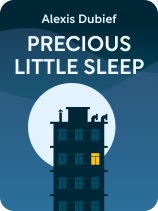

This article is an excerpt from the Shortform book guide to "Precious Little Sleep" by Alexis Dubief. Shortform has the world's best summaries and analyses of books you should be reading.
Like this article? Sign up for a free trial here.
What are some independent sleep training methods? Is it okay to let your babies cry it out?
Alexis Dubief outlines two methods for teaching your baby to sleep independently: the Assisted Sleep Method (ASM) and the Self-Soothe Method (SSM). She recommends you start with the more gradual ASM approach and move to SSM if needed.
Continue reading to learn about these two methods and how to use them over time.
Independent Sleep Methods
Be prepared for your baby to fuss and cry as they adjust to the major change of sleeping without your help. The author asserts that it’s normal for your baby to feel frustrated and upset as they struggle to learn something new. Your baby crying during this process doesn’t make you a bad parent—your job is to support them as they learn difficult things at every stage of their lives.
(Shortform note: Some infant sleep experts advocate for what they call No-Tears methods, where you avoid letting your baby cry during the process of teaching them to sleep. Advocates of this approach argue that allowing a baby to cry, even for a short period of sleep training, is cruel and can damage their development and your relationship with them. Many No-Tears advocates go so far as to claim that all sleep training approaches, like Dubief’s methods, are abusive. However, there’s no clear evidence to support their claim—the only evidence that crying can be detrimental to infants comes from studies on long-term abuse and neglect, whereas sleep training generally involves brief periods of crying for just a few days.)
According to the author, between 2 and 4 months of age is in the ideal window to begin independent sleep training. This is before the baby forms strong unsustainable sleep associations or hits challenging developmental milestones like teething. If you’re past that age window, no worries—simply start now. With consistency and commitment, your baby can learn how to sleep independently, which will greatly improve their sleep and yours. Once they master independent sleep, you can occasionally be flexible by offering them more soothing help during certain circumstances like illness and travel.
(Shortform note: Contrary to Dubief’s recommendation, some infant sleep experts say the ideal time to begin sleep training is around 5 months old. Before this age, babies go through major sleep cycle developments, so sleep training is often less effective and may involve more crying. After five months, babies’ melatonin levels and sleep patterns self-regulate, making sleep training easier. However, many note that the ideal timing depends on your individual child and family situation. Developmental milestones, illnesses, transitions, and parental readiness can all influence the best time to begin.)
The Assisted Sleep Method
Dubief outlines two ASM options that will help your baby learn to fall asleep without you. ASM requires your involvement, commitment, and patience, as the process can take days to weeks.
To implement ASM, read through the options and pick one to try for at least five to seven days. If that one doesn’t work, move on to a different ASM technique. You’ll know that your independent sleep teaching is successful when your baby wakes up less frequently at night, if at all, and when putting your baby to sleep is easy, timely, and enjoyable.
Option #1: Let Baby Fuss
This option is appropriate for babies 2 months and older.
- First, deploy all your soothing methods, including sleep aids and unsustainable associations like nursing, to get your baby drowsy.
- Put your baby down in their crib, sleepy but still awake.
- Walk away, allowing them 15-20 minutes of fussing and crying before returning to soothe them again. This fussing period gives them a chance to fall asleep on their own.
- If they fall asleep on their own, congratulations—this is your new strategy.
- If they don’t fall asleep after the waiting period, you have several options. If your baby is awake but not fussing too much, wait longer and see what happens. If they’re screaming, consider waiting a few more minutes. Some babies go from screaming to sleeping without a transition. If your baby is like this, listen to your parental instinct—they might fall asleep any second, or it might be a failed experiment, which is OK. If needed, go back and soothe your baby. Try again, or wait to try for a few days.
Option #2: Progressive Weaning
Babies who need your help to fall asleep tend to favor movement and physical contact (snuggling, bouncing, and rocking) or sucking (nursing and pacifier). Each category requires a different approach to give your baby more sleep independence incrementally. You’ll gradually reduce your involvement in the soothing process over days or weeks. Progressive weaning is appropriate for babies 2 to 6 months old.
For Movement-and-Touch Babies
- Rock or bounce your baby until they’re drowsy. Then put them in their crib, still awake.
- Gently jiggle and rock the crib until they fall asleep. At first, it may take them a long time to fall asleep—up to 30 minutes.
- The following nights, spend progressively less time jiggling the crib, reducing the duration by five minutes a night until you no longer need to jiggle.
- When you no longer need to jiggle the crib, simply put your baby down when they’re calm but awake and leave the room.
For Suckling Babies
The author says the best time to wean babies from their sleep associations with nursing, bottles, or pacifiers is before 5 months old. Start by allowing your baby to suckle before they go to sleep, but not while they fall asleep: Let them nurse, feed, or use a pacifier until they’re drowsy, then remove the suckling source and place them in the crib awake. If they remain calm, leave them to fall asleep on their own. If they protest, return the suckling source to re-settle them, then remove it again before they fall asleep. Repeat this cycle until they fall asleep without suckling. You might have to repeat the steps for the first few nights. Don’t give up. Eventually, a routine will emerge—a brief period of suckling followed by falling asleep by themselves in their crib.
The Self-Soothe Method
SSM, also known as the “cry-it-out” method, centers on putting your child in a safe sleep environment and allowing them to learn to self-soothe. This method may be stressful for your baby as they adjust, but Dubief asserts that healthy sleep is worth a brief period of distress—SSM usually takes only a few days of consistency to teach your baby to sleep independently.
To succeed with SSM, ensure a safe sleep space, be in 100% agreement with your co-parent about the plan, and prepare to fully commit without wavering, even through distress. The author asserts that this method requires your total commitment—any inconsistency will completely undermine your efforts. If you cannot bear to hear your baby cry without going to them, hold off on SSM until you’re emotionally ready to see it through without intervention.
How to Do SSM
To prepare, Dubief says to make sure your baby is napping well during the day so they’re not overtired. Do what you must to get your baby to nap, like stroller walks or car rides. Don’t worry about unsustainable sleep associations during naptime yet. Establishing independent sleep at night is your first priority, and you can address independent sleep at naptime later (we’ll discuss this in the next section).
Then, to implement SSM:
- Complete your usual routine at bedtime, using any sustainable associations that work to calm the baby, like swaddling or white noise. Move any unsustainable sleep associations like nursing, rocking, or cuddling to at least 20 minutes before bedtime.
- Put your baby down to sleep, drowsy but awake. Leave the room.
- Don’t go back in, no matter how much or how long your baby cries. Eventually, they will fall asleep.
Dubief explains that your baby will likely cry a lot the first night, typically 45 to 90 minutes, but they should cry progressively less the following nights. Most babies stop crying and fully acclimate to independent sleep after three to four nights. Have faith in your baby’s ability to learn this new skill. If they struggle with SSM after five or more nights, Dubief says one or more of the following may be happening: You’re going in to check on them, bedtime is too early or too late, or your bedtime routine isn’t right.
Troubleshoot Common Sleep Issues
Even after you successfully teach your baby to sleep independently with ASM or SSM, they may still experience some sleep issues, including waking frequently at night and waking up early in the morning (4:00 or 5:00 am).
Night Wakings: Night waking typically happens when babies either wake to feed or have remaining unsustainable sleep associations, like the pacifier. Younger babies typically need to eat during the night, while most older babies can fast longer. However, older babies who may not need to eat may still wake up if they’re in the habit of snacking at night. In these situations, you can use the same technique (ASM or SSM) you used for bedtime to wean them off unnecessary night feedings.
Early Morning Waking: If your baby wakes up too early, Dubief recommends you try using your ASM or SSM method to encourage them to return to sleep. Try this for at least a week or two before expecting consistently later wake-up times. Another trick is to give them a small “snack” feeding—this may buy you another sleep cycle without disrupting their independent sleep progress.
Dubief also suggests adjusting the baby’s bedtime to encourage them to sleep later. If the gap between your baby’s last nap and their bedtime is longer than that suggested in the sleep chart above, they may be overtired, which can cause their bodies to produce stress hormones which might lead them to awaken too early the next morning. Move their bedtime earlier by 15 minutes a day until it’s more in line with what’s typical for their age. Conversely, if your baby goes to bed very early (6:00 or 6:30 pm), they may wake early because they’ve gotten enough sleep. In this case, Dubief recommends you push their bedtime later by 15 minutes over five to seven days.

———End of Preview———
Like what you just read? Read the rest of the world's best book summary and analysis of Alexis Dubief's "Precious Little Sleep" at Shortform.
Here's what you'll find in our full Precious Little Sleep summary:
- Techniques and pointers for improving your baby’s sleep
- Practical guidelines for infant sleep safety
- A nap chart to help you understand your child’s nap needs according to age






